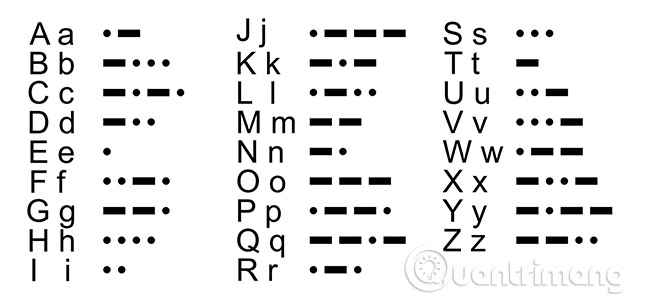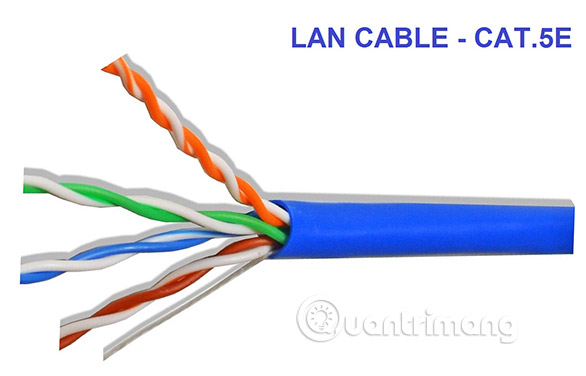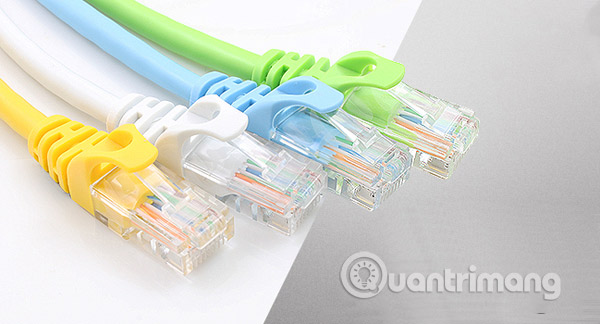Network wire history
Early life
We tend to see digital media as a new idea, but in 1844, a man named Samuel Morse sent a message across a distance of 37 miles (about 60km) from Washington DC to Baltimore, using His new invention is called 'The Telegraph'. This may seem far from today's computer networks, but the two principles are very similar.
Morse's code is a binary that uses dots and dashes in different sequences to represent letters and numbers, and the modern data network uses numbers 1 and 0 to achieve the same result. The biggest difference is, telegrams in the mid-19th century can transmit 2 or 3 dots and dashes every second, and computers today communicate at speeds above 1 Gigabit or in other words, 1,000 1,000,000 numbers 1 and 0 per second.

Soon after Morse's Telegraph invention, the French inventor named Emile Baudot developed a telegraph printer using typewriter keyboards, which allows almost anyone to send and receive telegram message. Baudot used a different type of code for his system because Morse code is no longer suitable. This is due to the length and irregular size of the bits needed for each letter. Baudot uses a 5-bit code to represent each character. This will usually only be able to provide 32 combinations (00000 to 11111 with 32 combinations).
Obviously not enough for 26 letters and 10 digits but he corrected this problem by using two shift characters for numbers and letters, performing the same type of function as a shift key of the machine. typing. Now, he has 62 combinations for letters, numbers and punctuation. To this day, serial communication speed is still measured by Baud rate, named after Emile Baudot.
Improvements were made to Baudot's machine by an English inventor named Donald Murray. Murray sold his machine license to Western Union, which gradually replaced all of his Morse telegraph machines with the new 'telegraph'.
Although very successful, the 5-bit Baudot code can only use capital letters, so it must be replaced with something that will allow more alphanumeric characters to be used. In 1966, a group of American media companies created a new code together, this time using 7 bits and could represent 128 characters. This is called the American Standard Code for Information Interchange or ASCII code. It is immediately accepted by almost all computer and communication companies in the world, except IBM, where the decision to set their own standards.
The version of IBM is the Extended Binary Coded Decimal Interchange Code or EBCDIC. It uses 8 bits and can represent 256 characters, but in addition to using it in mid-range computers and mainframes, it's never really popular. Unable to completely replace ASCII, IBM used ASCII code but expanded it using the 8th bit so that it could represent 256 characters, they called it 'Extended ASCII' (ASCII extension).
In just 30 years, everything has really grown at a rapid pace. This is due to the need for communication between computers at an increasing rate, so it entails promoting the "rush" development of network devices, network cables and parts. hard connection.
Develop new network technology
Ethernet was developed in the mid-1970s by Xerox Corporation at Palo Alto Research Center (PARC) in California, and in 1979, DEC and Intel collaborated with Xerox to standardize Ethernet systems for all users. The first technical document of three companies, called 'Ethernet Blue Book', was released in 1980, it was also called the 'DIX standard', based on the abbreviations of these three companies. It is a 10 Megabit per second system (10Mbps is equivalent to 10 million numbers 1 and 0 per second) and uses a large coaxial cable running through the building. The smaller coaxial cable is exploited at a distance of 2.5m to connect to the workstation. Large coaxial cables are often referred to as 'Thick Ethernet' or 10Base5, where '10' refers to speed (10Mbps), 'Base' represents the basic band system (full band used Its bandwidth set for each transmission, in contrast to the wide band, divides bandwidth into separate channels for simultaneous use) and '5' stands for the system's maximum cable length, in This case is 500m.

The Institute of Electrical and Electronics Engineers (IEEE) released the official Ethernet standard in 1983, called IEEE 802.3, named after the group responsible for the development of this standard, and in 1985 version 2 (IEEE 802.3a) has been released. This second version is often called 'Thin Ethernet' or 10Base2, in this case the maximum length is 185m, wearing the '2' number should be equivalent to 200m.
In 1984, IBM introduced the Token Ring capable of transmitting data at 4Mb / s. This system uses a thick 2-pair black cable with cover with very large 4 connectors. The IBM data connector, or sometimes called IDC, is a technical 'masterpiece'. Instead of using drives and plugs as usual, IBM was designed to be a kind of 'bisexual' device. Although IBM's cable system is still considered a high-quality and powerful data media to this day, it has lost the support of many customers. This is partly because the size and cost are too large, in part because it has only 4 cores and therefore is not as flexible as an 8-core UTP.
It is rumored that the Type 1 cable was initially tested to 300MHz, although it was only classified as a 20MHz cable for Token Ring and a newer version. Type 1A is reported to reach 600MHz and is classified as a 100MHz cable.
There are many other types of networks at the time (too much to cover in this article), using different cables and connectors, so a standard for telecommunications connection systems is obviously very necessary.
In 1985, the Computer Communications Industry Association (CCIA) asked the Electronic Industries Association (EIA) to build a cable standard to identify a telecom connection system. General information for commercial buildings. In essence, this will be a cabling system that can run all current and future networks through a common topology, using a medium and conventional connectors.
By 1987, some manufacturers had developed Ethernet devices that could use twisted-pair telephone cables and in 1990, IEEE released 802.3I 10BaseT Ethernet standard ('T' for twisted pair cables). . In 1991, EIA and the Telecommunications Industry Association (TIA) finally announced the first telecom cable standard called EIA / TIA 568, the structured cabling system. It is based on the type of unshielded twisted pair cable (UTP), and is closely monitored after a month by Technical Systems Bulletin (TSB-36) specifying a higher UTP cable type, categories 4 and 5 (or called Cat 4 and Cat 5).
Cat 4 has a designated data rate of up to 20MHz and Cat 5 up to 100MHz, which must have broadband to develop in the future. But now, less than ten years later, even Cat 5 is being pushed to its limits due to new network technologies.
Recently, the Cat 6a and Cat 7a standards have been published, and more information about these standards can be found in the Network Cabling Help e-book.
Important historical landmarks

To help you read easily, here are some important milestones in data communication history.
- May 24, 1844 - The Telegraph was invented by Samuel Morse.
- In 1845 - William Cooke and Charles Wheatstone received a patent for a telegraph in the UK.
- 1846 - A man named Royal House invented a printed telegraph requiring two mining devices at each end.
- In 1851 - Western Union Company was established from the merger of 12 telegraph companies.
- 1861 - The German inventor Phillip Reis invented a sound transmission device called 'Telephone'.
- 1874 - Jean-Maurice-Emile Baudot patented Baudot telegraph code.
- February 14, 1876 - Alexander Graham Bell applied for a patent for Telephone.
- February 14, 1876 - A few hours after Bell, Elisha Gray also filed for a patent for Telephone.
- In 1889 - Almon Brown Strowger invented the 'Dial Phone' and the 'Strowger Switch'.
- In 1948 - Bell Labs invented the transistor.
- 1966 - ASCII code was invented.
- 1969 - RS232 serial standard was formed.
- 1976 - Documentation of Ethernet published by Bob Metcalfe and David Boggs at PARC.
- 1979 - DEC and Intel partnered with Xerox to develop Ethernet.
- In 1980 - DEC, Intel and Xerox published the standard 'Ethernet Blue Book' also known as DIX.
- 1983 - IEEE 802.3 Ethernet standard published.
- 1984 - IBM introduced 4Mbps Token Ring.
- 1985 - IEEE 802.3b Ethernet standard, 10Base2 was formed.
- 1985 - IEEE 802.3b Ethernet standard 10Broad36, 10Mbps wide band usage.
- In 1987 - Fiber Optic Inter-Repeater Link (FOIRL) IEEE 802.3d and IEEE 802.3e 1Mbps Ethernet over twisted-pair cable appeared.
- 1990 - IEEE 802.3i Ethernet, 10BaseT standard was born.
- July 1991 - EIA / TIA 568 standard for telecommunication wiring in commercial buildings was born.
- August 1991 - EIA / TIA TSB 36 standard for premium cable (Cat 4 and Cat 5) was formed.
- August 1992 - EIA / TIA TSB 40 standard for advanced connection hardware launched.
- 1993 - The IEEE 802.3j 10BaseFL Ethernet standard was born, allowing fiber optic connection up to 2km.
- January 1994 - EIA / TIA TSB 40A standard was born - including more detailed wiring and testing.
- January 1997 - Standard EIA / TIA 568 was revised to EIA / TIA 568A, including TSB 36, TSB 40A and other revisions.
- 1995 - Standard IEEE 802.3u Fast Ethernet 100BaseTX (Cat 5/2 pairs), 100BaseT4 (Cat 3/4 pairs), 100BaseFX launches.
- 1997 - IEEE 802.3x Full duplex Ethernet standard released.
- 1997 - IEEE 802.3y Standard 100BaseT2 Fast Ethernet (Cat 3/2 pair) launched.
- 2001 - Cat 5e standard - ANSI / TIA / EIA-568-B.2 launched.
- 2002 - Cat 6 - ANSI / TIA / EIA-568-B.2-1 standard launched.
- 2008 - Cat 6A - ANSI / TIA / EIA-568-B.2-10 standard released.
- 2008 - EA and FA class standards - Modify 1 to ISO / IEC 11801, 2nd Ed released.
See more:
- Ethernet cable and how it works
- Distinguish common types of computer cables
- Basic knowledge of wireless networks and some typical wireless products
 History Ethernet
History Ethernet Top 10 best Wi-Fi cards
Top 10 best Wi-Fi cards Difference between Repeater and Amplifier
Difference between Repeater and Amplifier 8 best optical cable modems and cables 2018
8 best optical cable modems and cables 2018 Experience stream 4k HDR with AVerMedia Live Gamer 4K
Experience stream 4k HDR with AVerMedia Live Gamer 4K